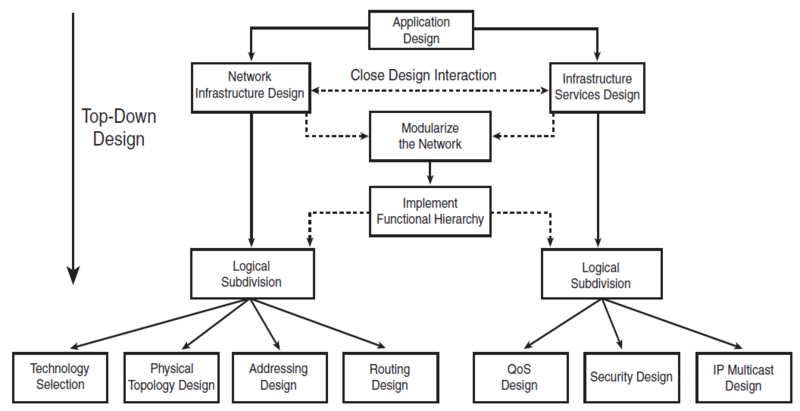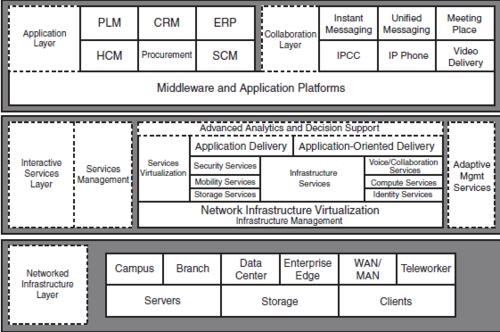CCDA/Network design methodology
SONA
- Service Oriented Network Architectur
Network Infrastructure Layer
The Network Infrastructure layer contains the Enterprise Network Architecture, which includes the Enterprise Campus, Enterprise Branch, data center, Enterprise Edge, WAN and LAN, and teleworkers.
The Cisco Enterprise Architecture is covered in Chapter 2, Network Structure Models. Servers, storage networks, and end-user clients reside at this layer.
This layer contains switching and routing elements to enhance performance and capabilities, including reliability and security. The network infrastructure is built with redundancy to provide increased reliability. Security configurations are applied to the infrastructure to enforce security policies.
Interactive Service Layer
This layer supports essential applications and the Network Infrastructure layer. Standardized network foundation and virtualization are used to allow security and voice services to scale better.
A standardized network architecture can be duplicated and further copied to scale a network.
Services provided at this layer fall into two categories: Infrastructure Services and Application Networking Services.
Infrastructure Services
The six infrastructure services are essential in the operation and optimization of network services and applications:
- Identity services include authentication, authorization, and accounting (AAA); Network Admission Control (NAC); and Network-Based Application Recognition (NBAR).
- Mobility services allow network access regardless of the location. An example is VPN.
- Storage services improve storage of critical data. Critical data must be backed up and stored offsite to allow for business continuity and disaster recovery.
- Compute services improve computing resources enterprise-wide. High-end servers can be used for virtual machines to scale the amount of servers on the network.
- Security services deliver security for all network devices, servers, and users. These services include intrusion detection and prevention devices.
- Voice and collaboration services allow user collaboration through all network resources. Cisco’s MeetingPlace is an example of a collaboration application.
Aplication Layer
- PLM: Product Lifecycle Management
- CRM: Customer relation Management Applications
- ERP: Enterprise Resource Planning Applications
- HCM: Human Capital Mangement
- Procurement Applications
- SCM: Supplu Chain Management
Collaboration applications include
- IM: Instant messaging
- UM: Unified Messaging
- IPCC: IP Contact Center
- Meeting Place
- Video delivery
PPDIOO
Prepare, Plan, Design, Implement, Operate and Optimize phases
Prepare Phase
The Prepare phase establishes organization and business requirements, develops a network strategy, and proposes a high-level architecture to support the strategy. Technologies that support the architecture are identified. This phase creates a business case to establish a financial justification for a network strategy.
Plan Phase
The Plan phase identifies the network requirements by characterizing and assessing the network, performing a gap analysis against best-practice architectures, and looking at the operational environment. A project plan is developed to manage the tasks, responsible parties, milestones, and resources to do the design and implementation. This project plan is followed during all phases of the cycle.
Design Phase
The network design is developed based on the technical and business requirements obtained from the previous phases. The network design provides high availability, reliability, security, scalability, and performance. The design includes network diagrams and an equipment list. The project plan is updated with more granular information for implementation. After the Design phase is approved, the Implement phase begins
Implement Phase
New equipment is installed and configured in the Implement phase. New devices replace or augment the existing infrastructure. The project plan is followed during this phase. Planned network changes should be communicated in change control meetings, with necessary approvals to proceed. Each step in the implementation should includes a description, detailed implementation guidelines, estimated time to implement, rollback steps in case of a failure, and any additional reference information. As changes are implemented they are also tested before moving to the Operate phase.
Operate Phase
The Operate phase maintains the network’s day-to-day operational health. Operations include managing and monitoring network components, routing maintenance, managing upgrades, managing performance, and identifying and correcting network faults. This phase is the design’s final test. During operation, network management stations should monitor the network’s general health and generate traps when certain thresholds are reached.
Optimize Phase
The Optimize phase involves proactive network management by identifying and resolving issues before they affect the network. The Optimize phase may create a modified network design if too many network problems arise, to improve performance issues, or to resolve application issues. The requirement for a modified network design leads to the network life cycle beginning.
PPDIOO Design metode
Prepare, Plan og design faserne
- Identificer de krav netværket skal leve op til
- Find ud af hvordan netværket fungerer idag
- Design det nye netværk
Prepare fase: Hvilke krav har kunden til netværket
- Hvilke netværks applikationer og services har kunden
- Nuværende og fremtidige
- Hvilke er vigtige for kunden (Business Critical)
- Hvad er organisationes mål
- Hvorfor vil de gerne have en nyt netværk. Hvad er de fremtidige mål. (Spare penge, være foran konkurenterne....)
- Er der nogle begrænsninger i organisationen
- Økonomi, tid, personale, politikker.....
- Definer de tekniske mål
- Response tid, fejlrate, sikkerhed, skalerbarhed, tilgængelighed
- Er der tekniske begrænsninger
- Genbrug af ældre udstyr, gamle protokoller...
Netværks checklist
Vær opmærksom på følgende tommelfingerregler
- HUB baserede segmenter skal være under 40% gemmensnitlig belastning
- WAN links skal være under 70% gemmensnitlig belastning
- Responsetid under 100 ms. Under 2 ms på et LAN.
- Ingen segmenter må have mere end 20% broadcast eller/og multicast trafik.
- Ingen segmenter må have mere end CRC fejl pr. megabyte trafik
- Ikke mere end 0,1% sendte pakker resulterer i en kollision.
- Hvis der er mere end 75% CPU belastning over en fem minutters interval i en enhed.
- Ikke mere end 100 drops i timen i en routers output queue (show interface)
- Ikke mere end 50 drops i timen i en routers input queue (show interface)
- Ikke mere end 25 buffer misses i en routers output queue i timen. (show buffers) se Understanding buffer misses and failures
- Antallet af ignorerede pakker ikke overstiger 10 i timen på Cisco routere
Router#<input>show interfaces fastEthernet 0/1</input>
FastEthernet0/1 is up, line protocol is up
Hardware is MV96340 Ethernet, address is 001b.54fb.2ea1 (bia 001b.54fb.2ea1)
Internet address will be negotiated using DHCP
MTU 1500 bytes, BW 100000 Kbit/sec, DLY 100 usec,
reliability 255/255, txload 1/255, rxload 1/255
Encapsulation ARPA, loopback not set
Keepalive set (10 sec)
Full-duplex, 100Mb/s, 100BaseTX/FX
ARP type: ARPA, ARP Timeout 04:00:00
Last input 00:00:00, output 00:00:02, output hang never
Last clearing of "show interface" counters never
Input queue: 0/75/<notice>0</notice>/0 (size/max/<notice>drops</notice>/flushes); <notice>Total output drops: 0</notice>
Queueing strategy: fifo
Output queue: 0/40 (size/max)
5 minute input rate 4000 bits/sec, 4 packets/sec
5 minute output rate 4000 bits/sec, 3 packets/sec
944 packets input, 149264 bytes
Received 944 broadcasts, 0 runts, 0 giants, 0 throttles
0 input errors, <notice>0 CRC</notice>, 0 frame, 0 overrun, <notice>0 ignored</notice>
0 watchdog
0 input packets with dribble condition detected
499 packets output, 276829 bytes, 0 underruns
0 output errors, <notice>0 collisions</notice>, 0 interface resets
3 unknown protocol drops
0 babbles, 0 late collision, 0 deferred
0 lost carrier, 0 no carrier
0 output buffer failures, 0 output buffers swapped outDesigne netværkets
Når netværket er designet testes løsningen med et pilotprojekt eller et prototype netværk.
Top-down design
Design netværket efter OSI modellen. Start med applikationer og arbejd dig ned. Top-down design følger SONA modellen. Se figur øverst.


